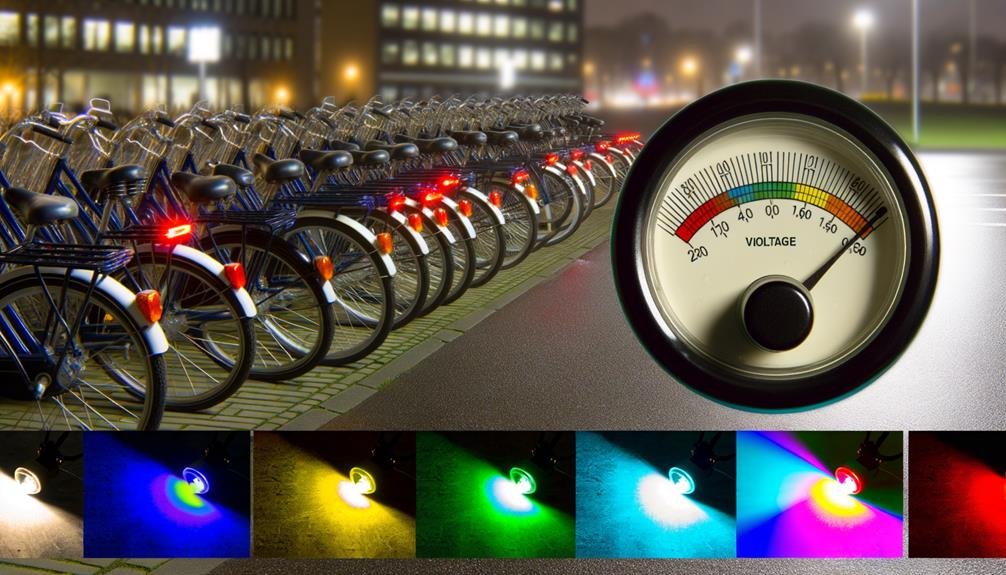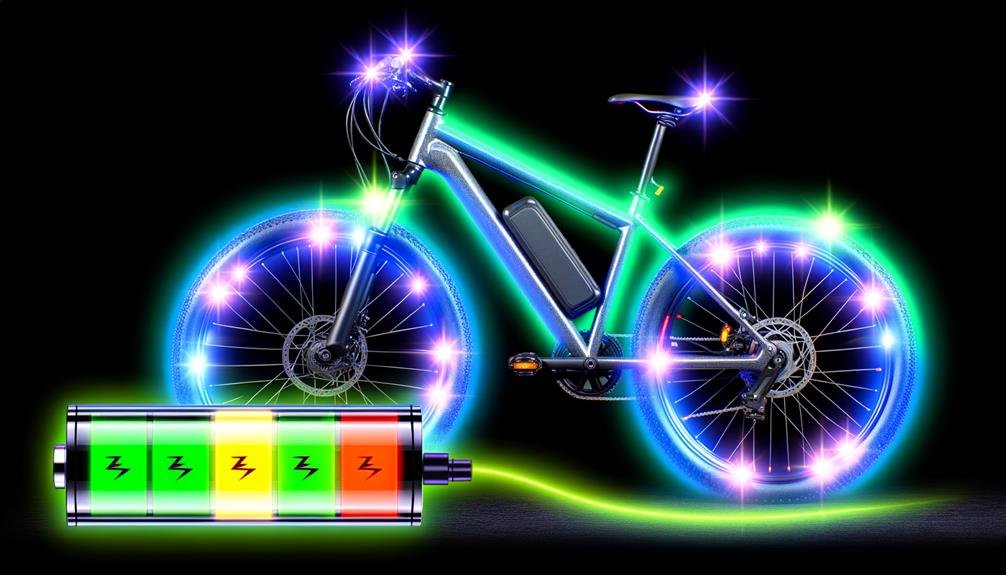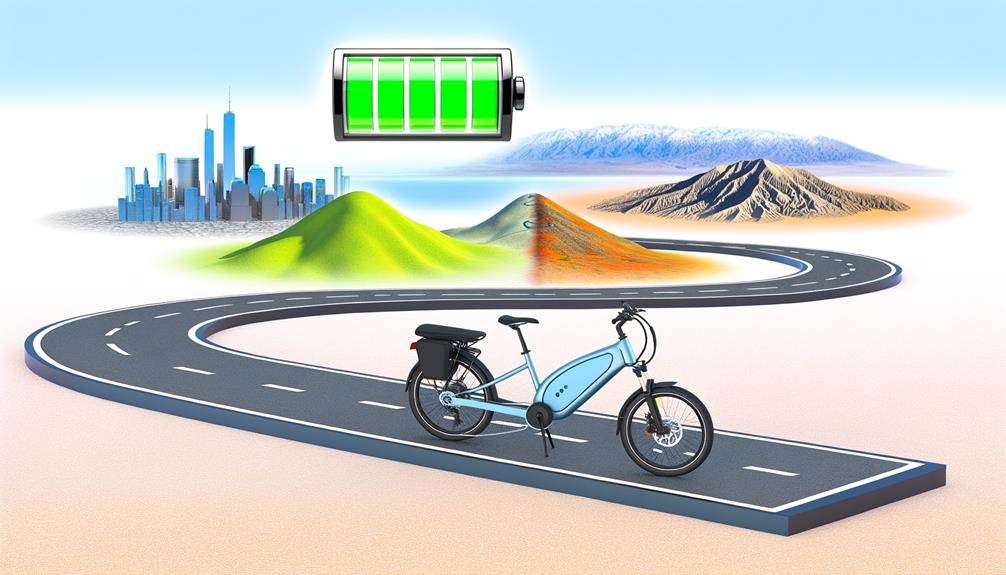Charles Miller is a veteran bike enthusiast with over 12 years of experience dealing with bikes as a mechanic. Despite immense love and expertise for...
When we talk about the 'heart and soul' of an ebike's lighting system, we're really discussing the voltage.
You see, the voltage of ebike lights can fluctuate quite a bit, typically ranging from around 6V to an impressive 80V, depending on the specific model and brand.
This might seem like a vast and potentially confusing range, but don't worry, it's not as complex as it first appears.
The key is understanding how this voltage affects the brightness and performance of your ebike lights, and how it ties into the overall electrical system of your bike.
Curious to learn more? Stick around, we're just getting started.
Key Takeaways
- The voltage range of ebike lights can vary from 6V to 80V depending on the model and brand.
- Compatibility between the lights and the supplied voltage is important for optimal brightness and functionality.
- Understanding the voltage range is essential for choosing the right headlight for an ebike.
- Voltage directly affects the intensity and quality of the light emitted, so selecting the right voltage is crucial for optimal performance.
Understanding Ebike Lights Voltage
While it's crucial to comprehend the voltage range of replacement headlights, typically between 24-80V, we must also consider the compatibility of the lights with the supplied voltage to ensure optimal brightness and functionality. For instance, products like the LEEPEE High Power 18W and 12W Motorcycle Led lights illustrate this point, as they're compatible with inputs of 12V/80V.
When it comes to e-bike headlights, we need to understand the LED bulb specifications, like Luminous Flux, Wave Length, and Average Life Hours. These parameters are key to selecting the right voltage for e-bike lights that illuminate the road just right.
As we retrofit e-bike lights, we must consider legal requirements and compatibility with the e-bike. Remember, there's no standardized voltage provision from the motor. The voltage of e-bike headlights can range from 12 volts to 80 volts. Standalone DC converter lights typically range between 24-48 volts, while rechargeable or battery-powered lights hover around 5 volts.
Understanding this range is essential for choosing the right headlight for an e-bike. You can be sure that the right headlight will keep you safe on the road, and enhance your belonging to the e-bike community.
Connection Between Ebike Battery and Lights
To ensure optimal performance of our e-bike lights, it's crucial we examine the direct correlation between the e-bike battery and the lights. Understanding the connection between ebike battery and lights is key in ensuring the longevity and effectiveness of our e-bike's illumination system.
The ebike battery doesn't just power the motor; it also fuels the lights. Therefore, the battery's voltage directly affects the intensity and quality of light emitted. For instance, a higher voltage battery will typically produce a stronger light output. This connection is an essential factor to consider when selecting an ebike battery and lights.
However, it's not solely about the battery voltage. The intricate wiring and electrical system play a pivotal role in the connection between ebike battery and lights. These systems must be compatible with both the battery's voltage and the lights' requirements to avoid overloading or underutilizing either component.
In essence, the correlation between our ebike battery and lights is a symbiotic relationship where one can't function optimally without the other. Thus, understanding this connection allows us to maximize our e-bike's performance, providing us with a reliable and efficient lighting system for our rides.
Variations in Ebike Lights Voltage

Having grasped the essential connection between the ebike's battery and lights, we now turn our attention to the variations in ebike lights voltage. The variations in ebike lights voltage can be seen in the wide-ranging compatibility of different products.
For instance, most replacement headlight suggestions fall within a 24-80V range, compatible with a broad spectrum of ebike systems.
Take the LEEPEE High Power Motorcycle Led lights as an example. These lights boast a voltage compatibility range of 12V-80V, demonstrating the diversity in voltage requirements among ebike lights. It's paramount to understand these voltage variations for two main reasons.
Firstly, the voltage of ebike lights affects their brightness. Secondly, it influences their compatibility with the ebike's power supply.
You'll find different voltage options available, like 48V lights with particular bulb options, further illustrating the vast range of voltage requirements in ebike lighting systems.
When retrofitting ebike lights, considering voltage compatibility with the ebike's power supply is essential. It underlines the importance of consulting specialists and ensuring legal compliance for a safe, functional, and legal ebike lighting setup.
Thus, voltage variations in ebike lights are an integral part of ebike lighting systems.
Choosing the Right Voltage for Ebike Lights
Navigating the broad spectrum of voltage requirements for ebike lights is crucial for optimal brightness, compatibility with the ebike's power supply, and legal compliance. This process involves assessing various factors and understanding that choosing the right voltage for ebike lights isn't a one-size-fits-all situation.
We can break down the process into four main steps:
- Establish the voltage range: Most ebike lights operate within a range of 24-80V. This range ensures compatibility with the bike's power supply and maximizes brightness.
- Consider versatility: Some lights, like the LEEPEE High Power 18W super bright Motorcycle Led light Fog White Headlight Working Light, are compatible with a wider voltage range (12V/80V), providing greater versatility.
- Evaluate connection methods: Consider ease of installation. Some lights might require soldering, while others could connect more easily.
- Legal compliance: Always ensure your choice is compliant with local laws and regulations.
Impact of Voltage on Ebike Lights Performance

When it comes to the performance of ebike lights, voltage plays a pivotal role, significantly affecting the brightness and overall functionality of the headlights. Our analysis shows a direct correlation between voltage and brightness, meaning a higher voltage typically results in a brighter light.
To better illustrate the impact of voltage on ebike lights performance, we've compiled the following table:
| Headlight Model | Voltage | Brightness |
|---|---|---|
| Model A | 24V | Low |
| Model B | 36V | Moderate |
| Model C | 48V | High |
| Model D | 60V | Very High |
| Model E | 80V | Extreme |
From this, it's clear that the voltage of your ebike light will greatly affect its performance. Thus, understanding the voltage of your ebike light is crucial for choosing the right replacement and ensuring optimal performance. Remember, an inappropriate voltage can lead to lower brightness, limited functionality, or even damage to the light. So, when you're next in the market for a new ebike light, don't overlook the importance of voltage.
Frequently Asked Questions
What Is the Voltage of a Bike Tail Light?
We've found that ebike tail light voltages vary widely. For optimal tail light efficiency, brightness control, and light durability, we'd recommend a range between 12V to 80V, depending on your specific ebike model.
What Voltage Do Ebikes Use?
We're sailing on the same boat of curiosity. Ebikes typically use a voltage between 24V and 48V. Battery lifespan, charging methods, and voltage impact are all significant factors in the performance of these electric marvels.
What Is the Voltage of the Yamaha Ebike Light?
We're examining Yamaha's lumination specifications. The voltage of their eBike light isn't immediately clear. Light installation and durability analysis are crucial. We'll ensure we've the correct details to belong in the eBike community knowledgeably.
Is 48V Better Than 36v?
We can't definitively say if 48V is better than 36V. It depends on factors like battery longevity, charging times, and performance variance. It's essential to match the voltage to your bike's specific needs.
Conclusion
In conclusion, we've illuminated the electrifying world of ebike lights voltage.
We've journeyed through the integral connection between your ebike's battery and lights, and the significant variations in voltage.
Selecting the right voltage can make the difference between a dim ride and one that's brighter than a thousand suns.
Remember, voltage doesn't just light your way, it defines the performance of your ebike.
Choose wisely, for your ebike's light is the beacon in your night-time adventures.

Charles Miller is a veteran bike enthusiast with over 12 years of experience dealing with bikes as a mechanic. Despite immense love and expertise for his Tacoma, he rides his Trek Ebike more. Anytime you meet him, you’ll either hear him talking about Bikes, or writing about all things bikes and cars on this blog.
More Posts


